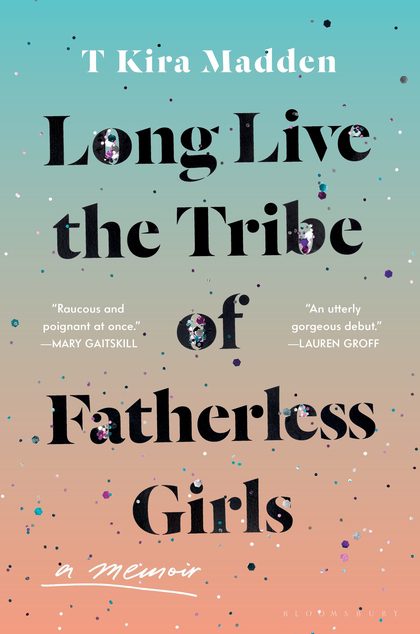
It would be easy to describe T Kira Madden’s debut memoir Long Live the Tribe of Fatherless Girls as a coming-of-age story, or as a memoir about trauma, or a memoir of growing up biracial or queer. The truth is, the book is all of those things and more. It is an examination of privilege and wanting, of the components that make up family, of addiction, and of healing. It is an apt representation of growing up in a culture where appearance matters—especially for young women—and finding out where you belong isn’t easy for many people.
In the blurbs, Claire Vaye Watkins compares the book to Dorothy Allison’s Bastard Out of Carolina, which is pretty apt. If you combine Allison with the fluid, raw style of Lidia Yuknavitch and the poetic language of Joy Harjo, you’d have Madden. Unafraid to face the things that threatened to destroy her again and again, she’s written a memoir that breaks open truths that she’s still discovering.
In addition to being a writer, photographer, and amateur magician, Madden is a founding editor-in-chief of No Tokens, a journal of art and literature that has a staff comprised of women and non-binary individuals. Her writing can be seen on a variety of sites, including Guernica, Tin House, Kenyon Review, Alma, and more.
I recently caught up with Madden via email to discuss her memoir, just released earlier this week.
***
The Rumpus: On Facebook recently, you posted a picture of yourself from ten years ago and wrote that at the time, you were taking night classes in fiction and were a fashion design student by day. When did you first start focusing on writing/think being a writer was doable?
T Kira Madden: If there were a movie montage of my life as a writer it would feature me, in various rooms and at various desks looking very confused, as if I accidentally and mistakenly made it to this book by some comedy of errors. The truth is, I work so hard. Ever since those first night classes at eighteen years old, I have approached writing as the greatest privilege and spiritual becoming of my life, but I’m still plagued with imposter syndrome every day, with every word. So, is it doable? Somehow, yes. But I still don’t believe it.
Rumpus: You’re one of the founders and the Editor-in-Chief of No Tokens. How has this influenced your development as a writer and your work?
Madden: Being an editor sharpens the eye and ear, yada yada, of course, but really, if we’re talking artistic development, founding and editing a journal has taught me everything about generosity and community building. The longer I’m here, the more I believe those qualities matter as much as craft. Spending time with so many submissions is heartening because it reminds me that we’re all in this, making things. For the most part, we’re all doing our best. As an editor, I’m approaching every piece looking for the best of it, the most stinging, awe-striking, crystalline moments, because I want to always fight for art, not against it.
Rumpus: At one point in the book, you say that “Maybe the unfinished story is the story.” Is that what spurred you to write the book? If not, what did?
Madden: I wish. If I knew that was the answer up front, it would have been a much easier book to write. Though perhaps if I’d known the answer I wouldn’t have written it at all. I’m always writing into questions. I’m writing to make shape out of that which I don’t understand. The most unshapely moments or people. I wrote the book to story my life and my father, and to find a linear tidiness to what’s happened to me, and, spoiler: I never found it. The unfinished story is the story, yes. Unfortunately and blissfully, that’s the truth.
Rumpus: One of the things that struck me as I read your book was the vivid sense of place. Having lived in Ft. Lauderdale for a brief time years ago, I felt that you really captured the surreal quality of South Florida—which can be so hard to describe on the page; it’s a feeling. Funny enough, in the same Facebook post referenced above, you had mentioned you hated Florida. Has that changed? Florida feels like such an important character in its own right in your book.
Madden: I want to love Florida. I want to cherish it. I want to feel changed and made by it. But honestly, my feelings about Florida are still too gnarled and close to parse out. I will say that reading Kristen Arnett’s “The Problem with Writing about Florida” for the first time—that really got to the bone of it. The impossibility; the “ache I can trust.” I’m glad Florida is a character in my book, and—as I hope all my characters are—I’m glad it’s complicated.
Rumpus: The section “Can I Pet your Back?” is almost a meditation on “pretty,” if you will. For me, it felt like a meditation on womanhood in general, on what it’s like growing up as a girl, navigating life and expectations as a female, etc. Where do you find “pretty” now, and where/how has that changed?
Madden: I think the simpler, crowd-pleasing answer might be to say I’ve put all the Boca behind me, and I no longer care about pretty and beauty and what it takes to ‘achieve’ it, but I’m from Boca! Beauty has its fangs in me. And also, that’s okay! There’s something incredibly icky and counterproductive and anti-feminist and anti-queer to say that true beauty and feminism is pure and without makeup and without vanity. Why the fuck can’t we send nudes to our friends and feel hot in a new outfit or splurge on skincare and a new Hi Wildflower lipstick when and if we can? Pretty, for me as an adult, is owning and maintaining a healthy relationship to pretty, a relationship full of boundaries and respect and always, always desire.
Rumpus: You included pictures in the last part of your book. Why pictures, and was there a reason they were only near the end?
Madden: I’ve always tried to sneak photographs into my work—fiction or nonfiction—blame W. G. Sebald. I like visual components as punctuation. If I had it my way I’d litter the whole book with photographs, but then you have to request various permissions, which can be tedious. Also, as I’ve learned, formatting can be tough when you’re working with images. Using them in the final section felt manageable and appropriate for the section; the section itself is very much about piecing together a mystery by going through old records, journals, and scrapbooks and revising the mythologies we’re told about our lives. The photos, and so many more photos that were cut, were the literal footprints I followed to find my way through the story.
Rumpus: I’m always interested in titles of books, and you have a section of your book with the same title as the book title. This section was one of my favorites, actually. For me, the sense of chosen family and how we find our groups was something with which I really identified. How did you choose this section’s title as your book title?
Madden: The short answer: I didn’t! “The Rat’s Mouth” was always the title of this book in my heart, but my editor had a great point that “The Rat’s Mouth” is a punchline. It closes, rather than opening. I always wanted titles that skewed darker, because I think the book is quite dark, but my agent and publishers really felt Long Live was a more triumphant title with more spirit. Now I can see they were absolutely right; people have found the book because of the title alone. There’s a sense of family or community in it, for sure. I’m so grateful for that.
Rumpus: How did you come up with the structure of your book? For me, it read almost like a series of connected snapshots, rather than a standard linear memoir of “this happened, then this, now this and this.”
Madden: I’m very much of the Lidia Yuknavitch Chronology of Water school of Grief Isn’t Linear. Why should our renderings have to be? I hadn’t read too many memoirs when I began this project and I think, in a way, that served me. I had no idea what a classic memoir was “supposed” to look like, so I wrote it the way I write everything: shattered, fragmented, out of order, thematically random. Later, with the help of my fantastic agent and my dream editor, I was able to begin ordering and composing the fragments into a piece of music. I’m so grateful that they helped me find a narrative arc but also supported me leaning into my weird. It’s a weird book. I don’t know how to write any other kind.
Rumpus: Who are the writers that inspire you, and what are the books you return to again and again?
Madden: In my book acknowledgements I mention Grace Paley, Lynda Barry, and Heather Lewis, and those three will always be my truest. Jayne Anne Phillips’s Black Tickets was The Book that made me want to write. I constantly return to my childhood Encyclopedia Brown series; I’m not great at plotting so reading page-turning plot on the most basic level is helpful for me. I love Kenzaburō Ōe and Kawabata and Gogol. Katherine Anne Porter! Annie Proulx and Joy Williams and Daniil Kharms and Ishiguro’s The Remains of the Day, which I find structurally perfect. Che Yeun and Justine Champine are two emerging writers who are about to split the world open. Alice Sola Kim and Osama Alomar are writing some of the best stories out there. Kristin Dombek and Jaquira Díaz, some of the best essays. And I will read any-fucking-thing Samantha Irby writes, ever.
Rumpus: What do you think you’ll be pursuing next? Are you working on anything in particular?
Madden: I, like almost every writer, am currently At Work On A Novel. I’ve been unwaveringly in love with this project for years now, and I hope it will show. Also, I’m going to finally take a shot at some lesbian screenwriting because I want to watch some goddamn lesbian movies and therefore somebody’s got to do it.
***
Photograph of T Kira Madden © Jac Martinez.





